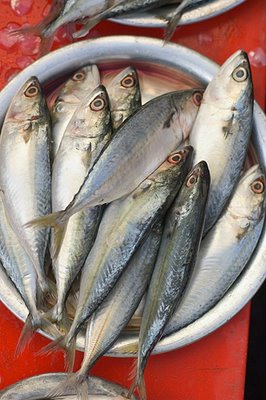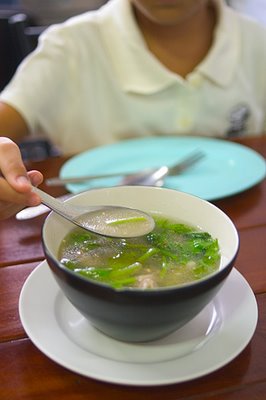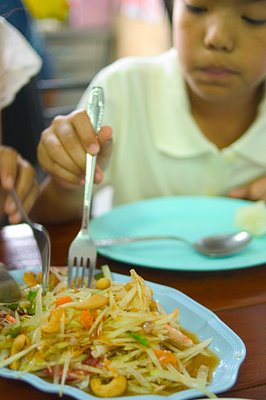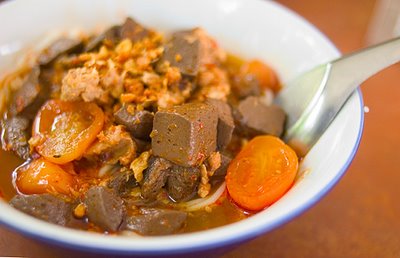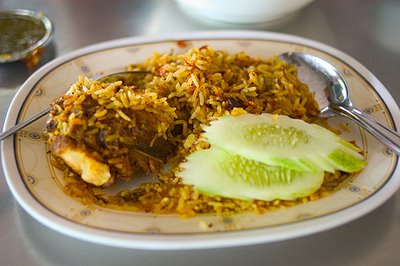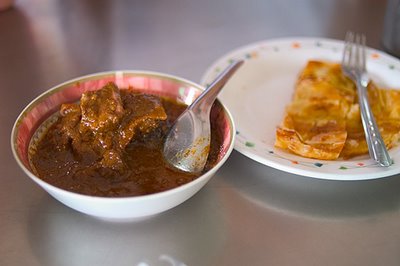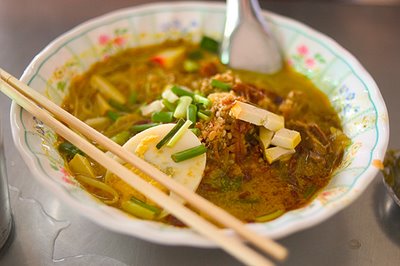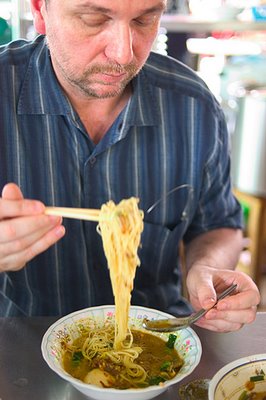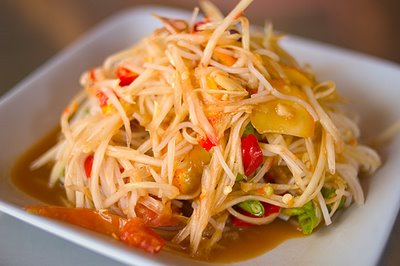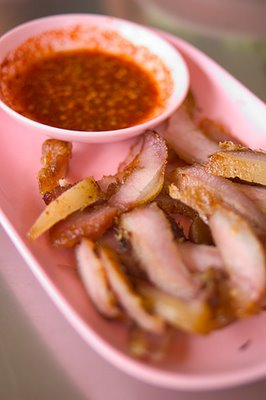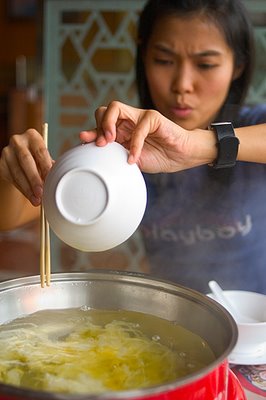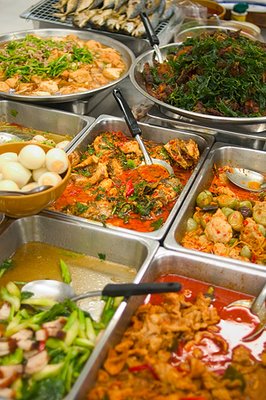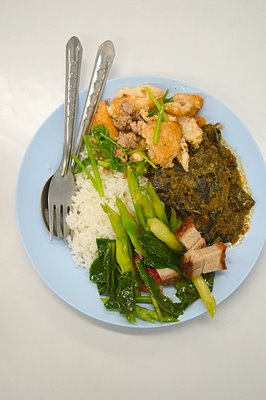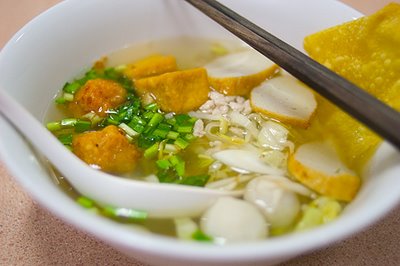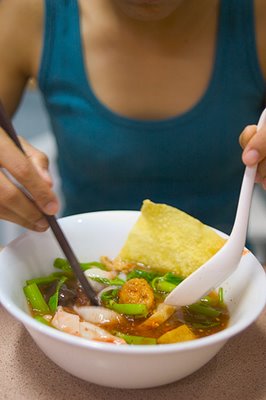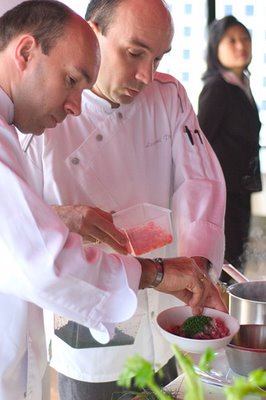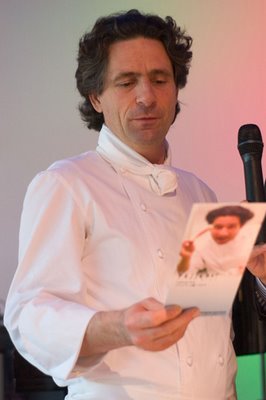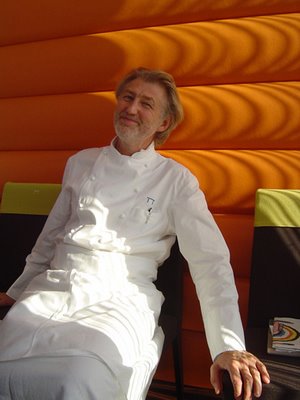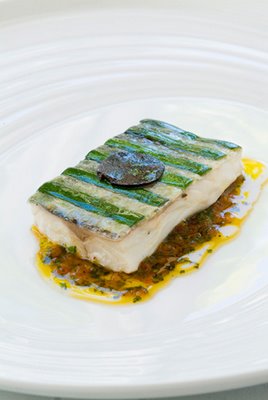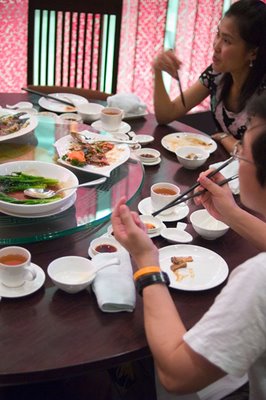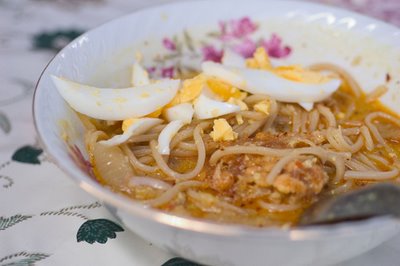Just got back from four days in Singapore for the World Gourmet Summit. More on that later... In the meantime, I've been wanting to post an article of mine that ran in Intermezzo magazine. The piece concerns the food of Laos, an interesting cuisine, and a current topic at eGullet. Enjoy!
Spicy, Salty, Sour and Sweet: My Second Taste of Laos (Intermezzo Volume No. 5, Issue 13)
In 1998, as a twenty-year-old junior at the University of Oregon, I received a scholarship to visit Laos with a group of students from various Southeast Asian countries. At that point the country had only recently opened its doors to international tourism, and when I arrived I had the distinct impression that I was somewhere unknown and unvisited by the outside world. Since my college years, I have spent most of my time living and working in Thailand. I have eaten countless amazing Thai dishes, and tasted the foods of nearly every country in Asia. Yet I'm constantly reminded of the food of Laos, and recently decided to revisit the places and tastes that proved to be so eye-opening to me as a student.
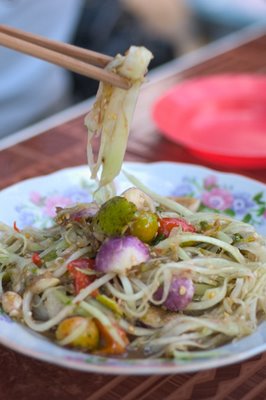
Tam baak hung, a tart salad of unripe papaya, eggplant and tomatoes, is a favorite meal in Laos.
What I ate in Laos eight years ago was so unlike anything that I had ever tasted before that it truly grabbed my attention. Several of my culinary experiences still remain vivid to this day, such as my first time eating sticky rice, being faced with an intimidating dish of raw beef laab, and eating a papaya salad so spicy I nearly fainted. Every meal seemed an adventure, the food being both unusual and exciting, and after all this I was shocked when, after arriving home, I heard Lao food brushed off as “like Thai food but less spicy”.

Beer Lao is considered by many to be the best beer in Southeast Asia.
The food of Laos is based on fresh ingredients and boasts assertive flavors. Being a poor, mountainous, landlocked country has had an impact on the cuisine that makes Lao cuisine completely distinct from its big brother to the West. To begin with, that most important of Asian staples, rice, is in Laos, very different than that of Thailand. Rather than fragrant, long-grained rice, the staple carb of Laotians is short-grained “sticky rice” known as khao niaow. And as Laos is fully landlocked, freshwater fish is an immensely important staple, as is game (including deer, wild birds, lizards and other ahaan paa, or "jungle food"). And that symbol of Chinese culinary imperialism, the wok, has made little inroad in Laos, where much of the food is grilled or prepared in soups rather than fried.
I begin my journey in Vientiane (pronounced “wieng jan”), the capital of the Lao People’s Democratic Republic. Although it’s only a short bridge crossing over the Mekong River from Thailand, Vientiane feels a world, and a generation away. Upon arrival in the city, one is greeted by crumbling colonial-era villas and towering shade trees, a palpably different experience from the largely characterless, concrete cities of Thailand. Schoolgirls wearing the Lao national costume, a long embroidered skirt called the phaa sin cycle by on bicycles, and monks wrapped in bright orange sweep leaves in front of Buddhist temples. The capital of Laos is essentially a sleepy, dusty town on the banks of the Mekong, undoubtedly how Thailand was a generation ago, and much of the isolation of the past 30 years has served to preserve a culinary heritage that, even today, is still very much intact.

Fresh lemongrass is a common ingredient in Lao cooking.
Upon arrival in Vientiane, I proceeded directly to the banks of the Mekong River to begin my culinary reeducation by sampling what is undoubtedly the most quintessential of Lao dishes, tam baak hung. Consisting of strips of shredded green, unripe papaya, sliced tomatoes, lime, garlic, and fish sauce all ground together with a mortar and pestle, this tart “salad” is a relatively simple but delicious meal. The deep wooden mortar used to make tam baak hung is ubiquitous in every part of Laos, and is almost always wielded by women. Some cooks pound aggressively, as if punishing the papaya, the mortar and the pestle at once, while others use the mortar and pestle more as mixing tools, gently coaxing the ingredients together. Regardless of how it is done, the bell-like hollow thud that resonates when the dish is being prepared is recognizable enough to make one’s mouth water. One particular element that makes a tam baak hung particularly Lao is the use of chilies. Despite what others may say, the majority of Laotians actually do like their food hot, and I still wince when I recall a dish of tam baak hung I had in 1998 that was so spicy, that after the almost intolerable initial heat, I began to feel an intense chili-induced “high”, and stumbled back to my hotel room in a near-stupor.
The spiciness of chilies is, along with sour, sweet and salty, one of the four essential tastes that makes up Lao cuisine. Sour flavors typically come from the use of lime juice or crushed tamarind pulp, and a dish’s sweet taste might be the result of cane or palm sugar. Saltiness is usually obtained through generous use of paa daek, a mud like, unpasteurized fermented fish sauce essential to Lao cooking. The use of paa daek lends Lao food a certain earthy flavour, not to mention the fact that many Lao people still prefer to eat ahaan paa, game taken from the jungle. Lao food is also earthy in its tones, many of the dishes brown from the use of ingredients such as mushrooms or paa daek, or green from the addition of fresh herbs.
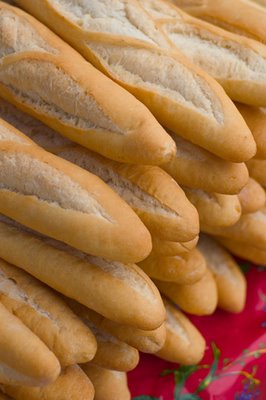
French-style baguettes for sale in Luang Prabang.
As with most countries in Asia, the staple food of the Lao people is rice. Not fluffy steamed rice, as in the vast majority of Asia, but rather, heavy, glutinous “sticky rice”. This form of rice grows well in Laos’s relatively high mountain valleys, and is prepared by being steamed over boiling water in wicker baskets, rather than by being immersed in water. In Lao households, sticky rice is often prepared in the morning then left in a permeable wicker container for the rest of the day, to be consumed with all meals. This container is known as a katip, and individual serving sizes, often used in restaurants, make good souvenirs. Sticky rice is eaten using the hands, and is rolled into a ping-pong sized ball with the right hand, and dipped into soups and dips. Eating sticky rice in Laos was the first time in my adult life that I had ever eaten entire meals with my hands, and I remember finding it a liberating and delicious experience.
To truly get a feel for Lao food, it helps to see the ingredients in their raw form. This is best done at any of the morning markets that take place every day at nearly every town in Laos. With this in mind, on my second day in Vientiane I wake up early to visit the hectic talaat sao, or morning market. Making my way past piles of lemongrass, pink joints of galingale and neatly bound bunches of dill and coriander, I wander over to the meat section, where entire chickens are on display, and bored-looking vendors shoo flies away from pork meat. Despite being a poor country, the inhabitants of Laos are generally rich with food, and consume meat on a regular basis. Thus, along with tam baak hung and sticky rice, the third essential element of Lao food is ping kai, grilled chicken. Grilled foods rule in Laos, and can range from fish to pork skin, but grilled chicken is the most popular, and arguably the most delicious. Chickens are typically first deboned before being rubbed with a mixture of cilantro root, garlic, turmeric, and salt, and are then splayed on a bamboo rack and grilled over hot coals. The result is smoky and savory, and along with tam baak hung and sticky rice, forms a complete Lao meal.

After a few days in Vientiane, I continue my culinary tour by traveling north to the former royal capital of Laos, Luang Prabang. Situated on a finger of land between the Mekong and Khan Rivers, Luang Prabang was declared a UNESCO World Heritage Site because of its pristine colonial-era and traditional Lao architecture. The city is one of the most pleasant and atmospheric places in Asia, if not the world, and is also where I had spent the majority of my time in Laos all those years ago.
I was eager to return to the places I had eaten in Luang Prabang, and made a point of making pho, Vietnamese-style noodle soup, my first meal upon arrival. Surprisingly for a landlocked, isolated country, there is a considerable amount of culinary influence from other countries, and pho is an example of this. However, Lao pho, unlike the beef-based Vietnamese original, is typically served with pork or buffalo meat. The soup is served with side of fresh herbs including Thai basil, sawtooth coriander, and the fragrant young mint leaves particular to Laos, as well as limes, pickled vegetables, chili paste, and deep-fried crispy rice cakes. It is this variety of condiments that makes pho such an individual eating experience. Almost instinctively, I added the herbs, squeezed my limes dry, crumbled the rice cake, mixed the soup, and the tart, herblike scent that resulted took me immediately back to my first time in the country.

Starfruit for sale in Vientiane.
Laos was part of French Indochina for more than 50 years, and other than Vietnamese food, along with French rule came certain inseparable European culinary traditions, including bread. It was in Luang Prabang where I first came in contact with khao ji, French-style baguette sandwiches that arrived in Laos via the Vietnamese. Using freshly baked bread, khao ji are often consumed at breakfast, the bread somehow always able to stay crisp and flakey despite the humidity, and spread with a variety of ingredients usually revolving around a form of pork-liver pate (no doubt also vestige of French influence) or the ubiquitous Vache Qui Rit cheese spread.
It is a desire for bread and yet another French legacy that impels me to wake up early on my first morning in Luang Prabang. My memory serves as my guide to a ramshackle mélange of benches and chairs known as Pasaneyom Lao Coffee. I am here to sample what must be the most ubiquitous French culinary legacy in Laos, coffee. The Laotians took this unfamiliar product and created their own method of brewing it, pouring hot water through a small baglike filter filled with coffee grinds. The resulting thick liquid is served small tumblers with sweetened condensed milk and followed by a “chaser” of green Chinese tea. The people of Laos also produce coffee, at one point the country’s beans, mostly grown in the southern part of the country, being among the costliest in the world.

Another remnant of foreign influence is the country’s beer. Laos is also home to what is considered by many to be the best beer in South East Asia, Beer Lao. Despite formerly being a monopoly (and thus not necessarily obliged to produce a good product), the state-owned Lao Brewing Company produces a fresh-tasting, hoppy lager-style beer, which when served ice-cold on a hot Lao day, is somehow even more refreshing than water. Beer in Laos is typically served with ice cubes, and sometimes, during the sweltering months of summer, bottles of Beer Lao are served wun, meaning that the beer is so cold it has reached a slushy, near frozen state.
While in Luang Prabang I was eager to sample the town’s unique local food, a cuisine that differs substantially from that of the rest of Laos. As in much of the country, the best and sometimes only place to sample local cuisine is at the evening market. Here freshly made curries, soups and salads are dished up to take home along with steaming hot sticky rice. In Luang Prabang, grilled Mekong River fish and ping kai can also be found, as well as a variety of jaew, a kind of chili-based “dip” eaten with sticky rice and vegetables. A particular specialty of Luang Prabang is jaew bong, roasted dried chilies pounded with garlic, shallots and buffalo skin. Jaew bong is traditionally eaten with sticky rice and paper-thin crispy sheets of dried Mekong river weed called khai phaen. After some deliberation, I buy both of these, as well as a bottle of ice-cold Beer Lao, and return to my hotel for a final celebratory meal. The occasion? I have tasted Laos again.
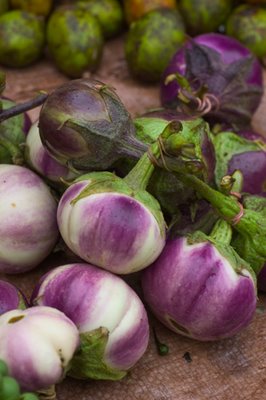
Lao eggplants come in a variety of shapes and colors.
Recipes:
Khao Niaow
Sticky Rice
Serves 4
In Laos, sticky rice is traditionally steamed in a cone-shaped bamboo basket called a huat The rice is placed over an aluminum pot designed to fit snugly with the huat. If you can find these at an Asian market, go ahead and use them, otherwise this recipe is adapted for use with a two-piece pasta pot.
2 cups Thai sticky rice
5 cups water
1. Soak sticky rice in water for four hours. Drain water and set rice aside.
2. Add water to a pasta pot until it is slightly below the bottom of the strainer. Line the removable strainer with cheesecloth, and add the sticky rice.
3. Insert strainer, tightly replace the lid, and bring water to a boil over high heat. Steam rice for 20 minutes, until grains are soft but firm.
4. When rice is done, remove cheesecloth with rice and open on a countertop, using a wooden spatula to spread the rice out flat, and let sit for five minutes.
5. Keep rice in a permeable container, such as a colander covered with cheesecloth, until needed, and serve warm, or at room temperature.
Tam Baak Hung
Papaya Salad
Serves 4
To shred the papaya, peel the papaya first, then use a cheese grater with large holes. Alternatively, for more hearty slices of papaya, use a sharp knife to dash several lengthwise cuts into the green, unripe papaya, then, using a knife or potato peeler, shave off strands of the papaya. The strips of papaya should be roughly cardboard thick and more or less as wide as a finger. In Laos, tam baak hung is made using a mortar and pestle, but as most people in the West don’t use these tools, this recipe is adapted for use with a sturdy bowl. In terms of seasoning the tam baak hung, in Laos this dish is made to taste, so if you prefer spicy, then add a few more chilies. If you dislike sour, then don’t add all of the lime juice and tamarind pulp. To this extent I have suggested adding only half of the seasoning ingredients initially, then adding the remainder to taste.
1 tablespoon tamarind pulp
5+ Thai chilies
2 cloves of garlic
3 cups shredded unripe papaya
5 cherry tomatoes halved
2 golfball-sized green or yellow Thai eggplants
1 tablespoon lime juice
3 tablespoons fish sauce
1 tablespoon of palm sugar (or white sugar)
1. Prepare tamarind by mashing the pulp up with 1/4 cup of warm water. Strain the resulting liquid and set aside.
2. Roughly chop chilies and garlic and smash with the broad side of a knife.
3. In a large bowl insert chili and garlic mixture and the shredded papaya and tomatoes. Slice the Thai eggplant directly into the bowl, and mix and grind all the ingredients using the bottom of a large wooden spoon, for about 20 seconds. The idea here is to gently bruise the papaya so that the other flavors will penetrate.
4. Add half of the tamarind, lime juice, fish sauce and sugar, and grind again. Taste for a balance of spicy, sour, sweet and salt, and add additional lime juice, fish sauce or sugar as needed.
5. Serve immediately with sticky rice.
Ping Kai
Lao-Style Grilled Chicken
Serves 4
In Laos entire chickens are typically deboned and splayed on bamboo racks before being grilled. For simplicity this recipe uses a whole chicken that has been jointed. Another option would be to use six chicken thighs.
1 chicken, jointed and cut into parts
2 tablespoons of salt
3 tablespoons of chopped cilantro roots
1/2 tablespoon peppercorns
4 tablespoons of chopped garlic
1 teaspoon turmeric powder
1 teaspoon fish sauce
1. Rub chicken parts with salt and set aside for 20 minutes to draw out any unpleasant juices.
2. In the meantime, using a mortar and pestle or food processor, finely grind cilantro roots, peppercorn, garlic and turmeric powder until a thick paste results. Stir in fish sauce.
3. Wash chicken pieces, pat dry, and coat with the paste. The previous steps can be done the day before and the chicken left to marinade in the paste overnight. Otherwise allow chicken to marinade in the paste at least 30 minutes before grilling.
4. Grill over a well-oiled grill on medium heat, turning every 10 minutes, until finished.
